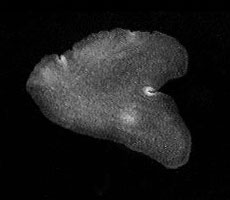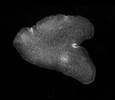Placozoa
Trichoplacidae
- Trichoplax adhaerens Schultze, 1883
- Treptoplax reptans Monticelli, 1893
References
Birstein, V. J. 1989. On the Karyotype of Trichoplax sp. (Placozoa). Biologisches Zentralblatt 108:63-67.
Blackstone, N. W. 2009. A new look at some old animals. PLoS Biol 7(1): e1000007 doi:10.1371/journal.pbio.1000007
Buchholz, K. and A. Ruthmann. 1995. The mesenchyme-like layer of the fiber cells of Trichoplax adhaerens (Placozoa), a syncytium. Zeitschrift für Naturforschung Section C 50:282-285.
Dellaporta, S. L., A. Xu, S. Sagasser, W. Jakob, M. A. Moreno, L. W. Buss, and B. Schierwater. 2006. Mitochondrial genome of Trichoplax adhaerens supports placozoa as the basal lower metazoan phylum. Proceedings of the National Academy of Sciences (U.S.A.) 103(23):8751-8756.
Ender, A. and B. Schierwater. 2003. Placozoa are not derived cnidarians: Evidence from molecular morphology. Molecular Biology and Evolution 20(1):130-134.
Grell, K. G. 1971. Trichoplax adhaerens, F. E. Schulze und die Entstehung der Metazoen. Naturwissenschaftliche Rundschau 24:160–1.
Grell, K. G. and A. Ruthmann. 1991. Placozoa. Pages 13-28 in Microscopic Anatomy of Invertebrates, Vol. 2. Placozoa, Porifera, Cnidaria, and Ctenophora. F. W. Harrison (ed.) New York: Wiley-Liss.
Hadrys, T, DeSalle R, Sagasser S, Fischer N, Schierwater B. The Trichoplax PaxB gene: a putative Proto-PaxA/B/C gene predating the origin of nerve and sensory cells. Mol Biol Evol (2005) 22::1569–78.
Miller, D. J. and E. E. Ball. 2005. Animal evolution: the enigmatic phylum Placozoa revisited. Current Biology 15(1):26-28.
Pearse V.B. and O. Voigt. 2007. Field biology of placozoans (Trichoplax): distribution, diversity, biotic interactions. Integrative and Comparative Biology 47(5):677-692.
Ruthmann, A., G. Behrendt, and R. Wahl. 1986. The ventral epithelium of Trichoplax adhaerens (Placozoa) - cytoskeletal structures, cell contacts and endocytosis. Zoomorphology 106:115-122.
Schierwater. B. 2005. My favorite animal, Trichoplax adhaerens. BioEssays 27:1294-1302.
Schuchert, P. 1993. Trichoplax adhaerens (Phylum Placozoa) has cells that react with antibodies against the neuropeptide Rfamide. Acta Zoologica 74:115-117.
Signorovitch, A. Y, S. L. Dellaporta, and L. W. Buss. 2005. Molecular signatures for sex in the Placozoa. Proceedings of the National Academy of Sciences (U.S.A.) 102(43):15518-15522.
Signorovitch, A. Y, S. L. Dellaporta, and L. W. Buss. 2006. Caribbean placozoan phylogeography. Biol. Bull. 211:149–156.
Srivastava, M., E. Begovic, J. Chapman, N. H. Putnam, U. Hellsten, T. Kawashima, A. Kuo, T. Mitros, A. Salamov, M. L. Carpenter, A. Y. Signorovitch, M. A. Moreno, K. Kamm, J. Grimwood, J. Schmutz, H. Shapiro, I. V. Grigoriev, L. W. Buss, B. Schierwater, S. L. Dellaporta, and D. S. Rokhsar. 2008. The Trichoplax genome and the nature of placozoans. Nature 454:955-960.
Syed, T. and B. Schierwater. 2002. The evolution of the Placozoa: a new morphological model. Senckenbergiana lethaea 82:259–270.
Syed, T. and B. Schierwater. 2002. Trichoplax adhaerens: Discovered as a missing link, forgotten as a hydrozoan, re-discovered as a key to metazoan evolution. Vie Milieu 52:177–187.
Thiemann, M. and A. Ruthmann. 1988. Trichoplax adhaerens Schulze, F. E. (Placozoa) - The formation of swarmers. Zeitschrift für Naturforschung Section C 43:955-957.
Thiemann, M. and A. Ruthmann. 1989. Microfilaments and microtubules in isolated fiber cells of Trichoplax adhaerens (Placozoa). Zoomorphology 109:89-96.
Thiemann, M. and A. Ruthmann. 1990. Spherical forms of Trichoplax adhaerens (Placozoa). Zoomorphology 110:37-45.
Thiemann, M. and A. Ruthmann. 1991. Alternative modes of sexual reproduction in Trichoplax adhaerens (Placozoa). Zoomorphology 110:165-174.
Ueda, T., S. Koya, and Y. K. Maruyama. 1999. Dynamic patterns in the locomotion and feeding behaviors by the placozoan Trichoplax adhaerence. Biosystems 54:65-70.
Voigt O., A.G. Collins, V.B. Pearse, J.S. Pearse, A. Ender, H. Hadrys, and B. Schierwater. 2004. Placozoa – no longer a phylum of one. Curr. Biol. 14:R944–R945.
Information on the Internet
- World Placozoa Database.
- Introduction to Placozoa. UCMP Berkeley.
- The Trichoplax Genome Project at the Yale Peabody Museum
- Genome of Simplest Animal Reveals Ancient Lineage, Confounding Array of Complex Capabilities. DOE Joint Genome Institute Press Release.
- Trichoplax Genome Sequenced: 'Rosetta Stone' For Understanding Evolution. Science Daily.
- Trichoplax: Pro-neuronal Genes. Andreas Heyland. Features movie clips of Trichoplax.
- A Weird Wee Beastie: Trichoplax adhaerens. Micscape Magazine article on Placozoa.
- Pharyngula on Trichoplax:
Title Illustrations

| Scientific Name | Trichoplax adhaerens |
|---|---|
| Reference | Blackstone, N. W. 2009. A new look at some old animals. PLoS Biol 7(1): e1000007 doi:10.1371/journal.pbio.1000007 |
| Specimen Condition | Live Specimen |
| Size | 2–3 mm |
| Source | A New Look at Some Old Animals |
| Source Collection | Public Library of Science (PLoS) |
| Image Use |
 This media file is licensed under the Creative Commons Attribution License - Version 2.5. This media file is licensed under the Creative Commons Attribution License - Version 2.5.
|
| Copyright | © 2009 Neil W. Blackstone |
About This Page
Page copyright © 2002
 Page: Tree of Life
Placozoa. Trichoplacidae.
The TEXT of this page is licensed under the
Creative Commons Attribution-NonCommercial License - Version 3.0. Note that images and other media
featured on this page are each governed by their own license, and they may or may not be available
for reuse. Click on an image or a media link to access the media data window, which provides the
relevant licensing information. For the general terms and conditions of ToL material reuse and
redistribution, please see the Tree of Life Copyright
Policies.
Page: Tree of Life
Placozoa. Trichoplacidae.
The TEXT of this page is licensed under the
Creative Commons Attribution-NonCommercial License - Version 3.0. Note that images and other media
featured on this page are each governed by their own license, and they may or may not be available
for reuse. Click on an image or a media link to access the media data window, which provides the
relevant licensing information. For the general terms and conditions of ToL material reuse and
redistribution, please see the Tree of Life Copyright
Policies.
- First online 28 August 2006
Citing this page:
Tree of Life Web Project. 2006. Placozoa. Trichoplacidae. Version 28 August 2006 (temporary). http://tolweb.org/Placozoa/2463/2006.08.28 in The Tree of Life Web Project, http://tolweb.org/









 Go to quick links
Go to quick search
Go to navigation for this section of the ToL site
Go to detailed links for the ToL site
Go to quick links
Go to quick search
Go to navigation for this section of the ToL site
Go to detailed links for the ToL site